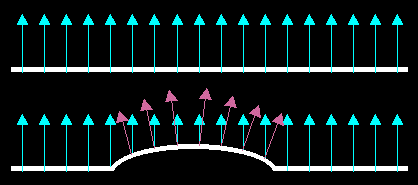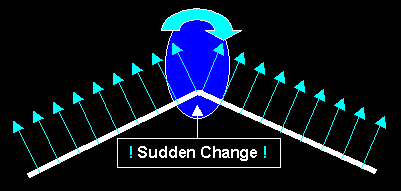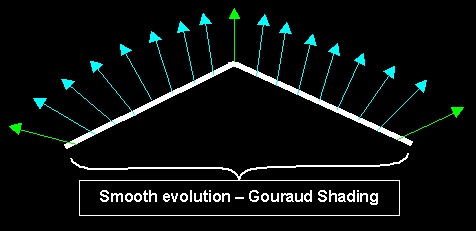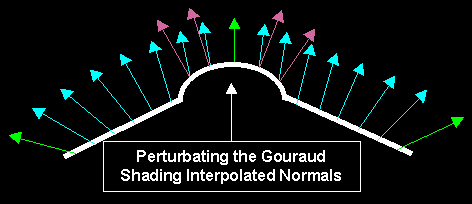
The standard example, top image shows an isolated polygon with its perpendicular normals. Bottom Image shows a bump and the resulting perturbed Normals in green.

The problem as indicated by McTaggart. When you move from the left polygon to the right polygon there is a sudden shift in the normal vectors. This would result in a sudden change in the light intensity value calculated. That would give results similar to flat shading.

The different start situation based on gouraud shading. The normal are interpolated between the given normals at the vertices (pink). The results is a smooth transfer from polygon to polygon. So no sudden shift in light intensity, so no artefacts.

The final example the smooth interpolated normals based on gouraud shading are perturbed to simulate a bump ( perturbed normals in green ).
So what about the embossing technique?
Well its a trick that doesn't look at normals at all so it shouldn't be called bump mapping in the first place. It is a trick to generate a quick lightmap that simulates bumps. It has several serious disadvantages but people do not seem to realize or see that.
First of all there is a huge impact on fill rate for almost every mainstream accelerator out there. The embossing technique requires you to upload your bump map (actually use it to texture map your polygon with it) then subtract (an available blending mode : A - B) that same bump map slightly shifted. The result in your frame buffer is a lightmap that simulates the shadows OR the highlights for bumps. The last thing to do is combine that lightmap with your actual texture. The average accelerator : G200, S3 Savage, Banshee, PVRSG, ... will see its fill rate cut in 3 since the technique requires 3, yes three, passes for the same polygon. Naturally this immediately means that bumpmapping using the embossing technique will be classes as a gimmick, something you use once in a level, maybe once in your game. Do not count on bumpmapping all the polygons in your scene using embossing unless everybody buys a Voodoo2 (still needs 2 passes so not that fast either), a TNT ( *if* it delivers) or a Permedia3 ( claims to do it in one pass... yeah right ;) ).
Another disadvantage is that you can *NOT* create every bump that you want, try fiddling around with the system in your favourite drawing program and you will see that the result of the substraction is very often not what you wanted. The technique needs trial and error before you get the result that you want. Even worse all your bumps need to have the same height since the height is determined by the shift and since the whole bump map is shifted in one go everything needs to have the same height. Even worse try creating a golf ball or orange skin like effect... I tried it and I failed to do it (could be just me but I doubt it). If you can give me a bump map and instructions to create the effect than I will be very happy. Mail me your solution (no price, just honour).
Oh and what about this : how do you determine the shift ? Nobody mentions that... wonder why... if you give every polygon in your scene the same shift that the result will be wrong since most polygons are at different positions related to the light source. This means recalculating the shift for every polygon in your scene, try doing a realistic sphere... so we have CPU dependency. Even worse this shift can thus be quite different between 2 polygons, so if your polygons are rather big then the shift between 2 neighbouring polygons can be so big that you can see a shift in your shadow map... SURPRISE... a similar problem as the problem suggested for the perturbed normal bump mapping ;)
There was an unbiased discussion about bumpmapping on the usenet between less know games coders (they do not have .plan -files). And they were rather unhappy with the limitations of the embossing technique, most saw it as a gimmick that is nice but no good for real use. Most said it would be nice to emboss their logo in some polygon at some level but that would be it... funny what did the 3Dfx Donut Demo do... yep that's right it embosses the 3Dfx logo in a donut... the donut is probably constructed out of lots of small polygons to avoid big sudden shifts of the shift of the bump map.
In general I would like to say if you take the time to give comments on one technique remember to also give comments about the other techniques unless you have a site that is biased to one type of 3D technology ;)
As always I could be wrong about anything I write here, there is no guarantee that the perturbed normal bump mapping method of PVRSG indeed supports the interpolated normals similar to gouraud shading. I will contact VideoLogic and ask. If you have comments or questions : mail me...
